Attractions · Europe · Germany · Going Out · Regions · Western Europe
5 best places to see Berlin as the City of Spies
Shadowy spies with dark secrets stalked the streets of Berlin for so many years that they coloured the character of the place. Cold War tensions between East and West were never clearer than at the Berlin Wall, whose towering blocks of concrete and giant scrolls of barbed wire divided the city in two. On both sides, spies masqueraded as diplomats and military strategists prepared for every conceivable conclusion to the communist-capitalist deadlock, including nuclear war. Little wonder, then, that novelists and movie-makers were inspired to create thrillers located in Cold War Berlin – but truth was even stranger than fiction, and you can see how at these fascinating and sometimes shocking sites.
Checkpoint Charlie
At this iconic guardhouse on Friedrichstrasse, armed soldiers operated the barriers of the main border crossing for foreigners and diplomats between West and East Berlin. It was here, during the Berlin Crisis of October 1961, that Russian and American tanks faced each other in a tense two-day standoff. Today theres a replica guardhouse on the site and a free open-air exhibit recalling key events in Cold War history. More impressive is the nearby Haus am Checkpoint Charlie museum, where you can see an original East German watchtower, plus photos and artefacts showing the ingenious ways in which East Germans risked their lives attempting to escape to the West.
 Teufelsberg
Teufelsberg translates as Devils Mountain – an appropriately sinister name for a 260-feet hill which was built out of rubble from WWII, buried an uncompleted Nazi military-technical college designed by Hitlers chief architect Albert Speer, and housed on its summit the biggest spy station in Europe. This listening post, operated by the US National Security Agency, once employed 1,500 people to monitor radio communications in Soviet Russia, East Germany and other Warsaw Pact nations. Five large, geodesic radar domes still stand here, the torn fabric of their outer skins slapping the sides of the buildings in the hill breeze. Artists paint on the walls, musicians play inside the domes echoing chambers, families gather outside for picnics, mountain bikers and hikers negotiate winding tracks around the hill, and all can enjoy a great view out over the Grünewald forest and Havel lake.
Teufelsberg
Teufelsberg translates as Devils Mountain – an appropriately sinister name for a 260-feet hill which was built out of rubble from WWII, buried an uncompleted Nazi military-technical college designed by Hitlers chief architect Albert Speer, and housed on its summit the biggest spy station in Europe. This listening post, operated by the US National Security Agency, once employed 1,500 people to monitor radio communications in Soviet Russia, East Germany and other Warsaw Pact nations. Five large, geodesic radar domes still stand here, the torn fabric of their outer skins slapping the sides of the buildings in the hill breeze. Artists paint on the walls, musicians play inside the domes echoing chambers, families gather outside for picnics, mountain bikers and hikers negotiate winding tracks around the hill, and all can enjoy a great view out over the Grünewald forest and Havel lake.
 Glienicke Brücke
Nicknamed the Bridge of Spies, the Glienicke Brücke was a Cold War border crossing between the communist Eastern Bloc and West Berlins American sector. Here in February 1962 the Americans released Soviet spy Colonel Rudolf Abel in exchange for American pilot Francis Gary Powers, whose U-2 spy plane had been shot down during a reconnaissance mission over Soviet Union airspace. The bridge later witnessed more spy exchanges and featured in TV dramas, movies and novels such as John Le Carrés Smileys People and Len Deightons Funeral in Berlin. All this makes it oddly exhilarating to walk across the bridge freely – and its location puts you close to the charming old streets of Potsdam and Frederick the Greats spectacular Sanssouci palace and park.
Glienicke Brücke
Nicknamed the Bridge of Spies, the Glienicke Brücke was a Cold War border crossing between the communist Eastern Bloc and West Berlins American sector. Here in February 1962 the Americans released Soviet spy Colonel Rudolf Abel in exchange for American pilot Francis Gary Powers, whose U-2 spy plane had been shot down during a reconnaissance mission over Soviet Union airspace. The bridge later witnessed more spy exchanges and featured in TV dramas, movies and novels such as John Le Carrés Smileys People and Len Deightons Funeral in Berlin. All this makes it oddly exhilarating to walk across the bridge freely – and its location puts you close to the charming old streets of Potsdam and Frederick the Greats spectacular Sanssouci palace and park.
 Ghost stations
The eeriness of travelling underground beneath border crossings into enemy territory was an experience shared by many West Berliners during the 28 years the city was divided by the Wall. On their route from one side of West Berlin to the other, several underground U-Bahn and S-Bahn lines travelled through part of communist East Berlin, the trains slowing but never halting at dimly-lit platforms where pale faced East German soldiers stared out from the tiny glassless windows of concrete sentry boxes. The guards were locked into these boxes to prevent them from trying to escape west along the tracks. West Berliners called these abandoned platforms Geisterbahnhőfe – ghost stations – and above ground in the East they were spirited away, their entrances bricked-up or hidden completely, their names eradicated from maps. An exhibition at the Nordbanhof S-Bahn station recalls this subterranean twilight zone. Just across the street, on Bernauer Strasse, the Berlin Wall Memorials 0.9-mile stretch of wall includes a section of the 100-foot-wide buffer zone which became known, because of the way escape attempts were brutally ended there, as the death strip.
Ghost stations
The eeriness of travelling underground beneath border crossings into enemy territory was an experience shared by many West Berliners during the 28 years the city was divided by the Wall. On their route from one side of West Berlin to the other, several underground U-Bahn and S-Bahn lines travelled through part of communist East Berlin, the trains slowing but never halting at dimly-lit platforms where pale faced East German soldiers stared out from the tiny glassless windows of concrete sentry boxes. The guards were locked into these boxes to prevent them from trying to escape west along the tracks. West Berliners called these abandoned platforms Geisterbahnhőfe – ghost stations – and above ground in the East they were spirited away, their entrances bricked-up or hidden completely, their names eradicated from maps. An exhibition at the Nordbanhof S-Bahn station recalls this subterranean twilight zone. Just across the street, on Bernauer Strasse, the Berlin Wall Memorials 0.9-mile stretch of wall includes a section of the 100-foot-wide buffer zone which became known, because of the way escape attempts were brutally ended there, as the death strip.
 Stasi Museum
Spying in Berlin wasnt motivated only by mutual suspicions between East and West. Soviet-controlled East Germany, ironically named the German Democratic Republic, also spied on its own citizens to oppress opposition. The Ministry for State Security (Stasi) had 91,000 employees and a further 173,000 informants who spied on work colleagues, friends, and family. Wire-tapping, opening mail, and video-observation were all practiced zealously. One of the Stasis big, foreboding buildings on Ruschestrasse, where much of the interior is unchanged since those times, now houses the Stasi-Museum.
Stasi Museum
Spying in Berlin wasnt motivated only by mutual suspicions between East and West. Soviet-controlled East Germany, ironically named the German Democratic Republic, also spied on its own citizens to oppress opposition. The Ministry for State Security (Stasi) had 91,000 employees and a further 173,000 informants who spied on work colleagues, friends, and family. Wire-tapping, opening mail, and video-observation were all practiced zealously. One of the Stasis big, foreboding buildings on Ruschestrasse, where much of the interior is unchanged since those times, now houses the Stasi-Museum.
 Images: Shutterstock
Images: Shutterstock
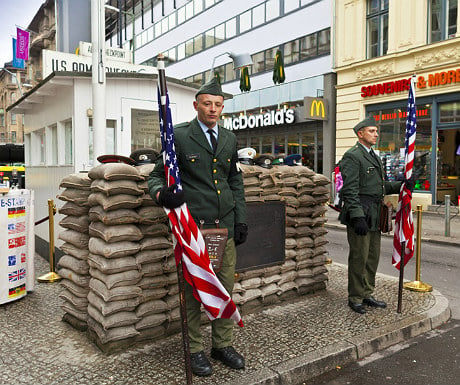 Teufelsberg
Teufelsberg translates as Devils Mountain – an appropriately sinister name for a 260-feet hill which was built out of rubble from WWII, buried an uncompleted Nazi military-technical college designed by Hitlers chief architect Albert Speer, and housed on its summit the biggest spy station in Europe. This listening post, operated by the US National Security Agency, once employed 1,500 people to monitor radio communications in Soviet Russia, East Germany and other Warsaw Pact nations. Five large, geodesic radar domes still stand here, the torn fabric of their outer skins slapping the sides of the buildings in the hill breeze. Artists paint on the walls, musicians play inside the domes echoing chambers, families gather outside for picnics, mountain bikers and hikers negotiate winding tracks around the hill, and all can enjoy a great view out over the Grünewald forest and Havel lake.
Teufelsberg
Teufelsberg translates as Devils Mountain – an appropriately sinister name for a 260-feet hill which was built out of rubble from WWII, buried an uncompleted Nazi military-technical college designed by Hitlers chief architect Albert Speer, and housed on its summit the biggest spy station in Europe. This listening post, operated by the US National Security Agency, once employed 1,500 people to monitor radio communications in Soviet Russia, East Germany and other Warsaw Pact nations. Five large, geodesic radar domes still stand here, the torn fabric of their outer skins slapping the sides of the buildings in the hill breeze. Artists paint on the walls, musicians play inside the domes echoing chambers, families gather outside for picnics, mountain bikers and hikers negotiate winding tracks around the hill, and all can enjoy a great view out over the Grünewald forest and Havel lake.
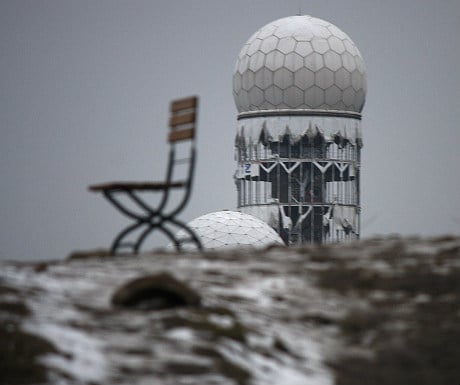 Glienicke Brücke
Nicknamed the Bridge of Spies, the Glienicke Brücke was a Cold War border crossing between the communist Eastern Bloc and West Berlins American sector. Here in February 1962 the Americans released Soviet spy Colonel Rudolf Abel in exchange for American pilot Francis Gary Powers, whose U-2 spy plane had been shot down during a reconnaissance mission over Soviet Union airspace. The bridge later witnessed more spy exchanges and featured in TV dramas, movies and novels such as John Le Carrés Smileys People and Len Deightons Funeral in Berlin. All this makes it oddly exhilarating to walk across the bridge freely – and its location puts you close to the charming old streets of Potsdam and Frederick the Greats spectacular Sanssouci palace and park.
Glienicke Brücke
Nicknamed the Bridge of Spies, the Glienicke Brücke was a Cold War border crossing between the communist Eastern Bloc and West Berlins American sector. Here in February 1962 the Americans released Soviet spy Colonel Rudolf Abel in exchange for American pilot Francis Gary Powers, whose U-2 spy plane had been shot down during a reconnaissance mission over Soviet Union airspace. The bridge later witnessed more spy exchanges and featured in TV dramas, movies and novels such as John Le Carrés Smileys People and Len Deightons Funeral in Berlin. All this makes it oddly exhilarating to walk across the bridge freely – and its location puts you close to the charming old streets of Potsdam and Frederick the Greats spectacular Sanssouci palace and park.
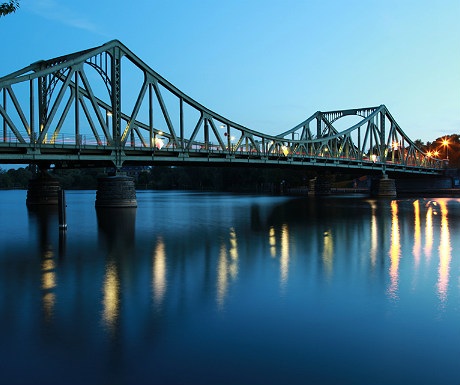 Ghost stations
The eeriness of travelling underground beneath border crossings into enemy territory was an experience shared by many West Berliners during the 28 years the city was divided by the Wall. On their route from one side of West Berlin to the other, several underground U-Bahn and S-Bahn lines travelled through part of communist East Berlin, the trains slowing but never halting at dimly-lit platforms where pale faced East German soldiers stared out from the tiny glassless windows of concrete sentry boxes. The guards were locked into these boxes to prevent them from trying to escape west along the tracks. West Berliners called these abandoned platforms Geisterbahnhőfe – ghost stations – and above ground in the East they were spirited away, their entrances bricked-up or hidden completely, their names eradicated from maps. An exhibition at the Nordbanhof S-Bahn station recalls this subterranean twilight zone. Just across the street, on Bernauer Strasse, the Berlin Wall Memorials 0.9-mile stretch of wall includes a section of the 100-foot-wide buffer zone which became known, because of the way escape attempts were brutally ended there, as the death strip.
Ghost stations
The eeriness of travelling underground beneath border crossings into enemy territory was an experience shared by many West Berliners during the 28 years the city was divided by the Wall. On their route from one side of West Berlin to the other, several underground U-Bahn and S-Bahn lines travelled through part of communist East Berlin, the trains slowing but never halting at dimly-lit platforms where pale faced East German soldiers stared out from the tiny glassless windows of concrete sentry boxes. The guards were locked into these boxes to prevent them from trying to escape west along the tracks. West Berliners called these abandoned platforms Geisterbahnhőfe – ghost stations – and above ground in the East they were spirited away, their entrances bricked-up or hidden completely, their names eradicated from maps. An exhibition at the Nordbanhof S-Bahn station recalls this subterranean twilight zone. Just across the street, on Bernauer Strasse, the Berlin Wall Memorials 0.9-mile stretch of wall includes a section of the 100-foot-wide buffer zone which became known, because of the way escape attempts were brutally ended there, as the death strip.
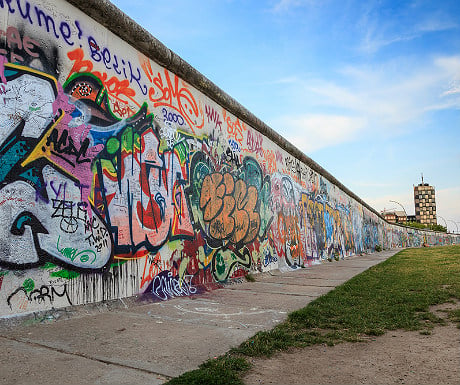 Stasi Museum
Spying in Berlin wasnt motivated only by mutual suspicions between East and West. Soviet-controlled East Germany, ironically named the German Democratic Republic, also spied on its own citizens to oppress opposition. The Ministry for State Security (Stasi) had 91,000 employees and a further 173,000 informants who spied on work colleagues, friends, and family. Wire-tapping, opening mail, and video-observation were all practiced zealously. One of the Stasis big, foreboding buildings on Ruschestrasse, where much of the interior is unchanged since those times, now houses the Stasi-Museum.
Stasi Museum
Spying in Berlin wasnt motivated only by mutual suspicions between East and West. Soviet-controlled East Germany, ironically named the German Democratic Republic, also spied on its own citizens to oppress opposition. The Ministry for State Security (Stasi) had 91,000 employees and a further 173,000 informants who spied on work colleagues, friends, and family. Wire-tapping, opening mail, and video-observation were all practiced zealously. One of the Stasis big, foreboding buildings on Ruschestrasse, where much of the interior is unchanged since those times, now houses the Stasi-Museum.
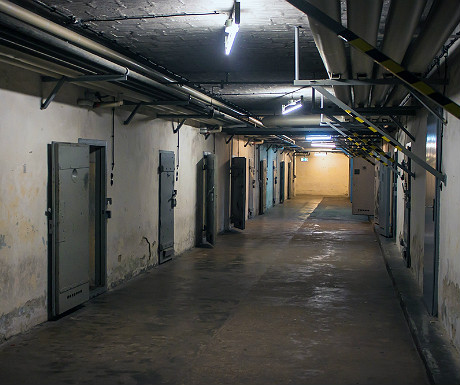 Images: Shutterstock
Images: ShutterstockDid you enjoy this article?
Receive similar content direct to your inbox.


Nice to know about some historical facts of some remarkable attractions in Berlin… I think the Berlin Wall is one of the must visit tourist attractions in Berlin not because its very beautiful but because it has great historical significance…..
Hello! Thank you a lot for this artcile! I didn’t know about Glienicke Brücke. I am going to Berlin soon and it will be nice to discover some great spots.
Excellent article. I’m planning a trip to Europe next year and I am looking for interesting places to visit.
Very interesting about the train stations
Oooooh great angle Phillip. I love Berlin and actually do associate it with spy movies and intrigue. Berlin’s edgy-ness is exciting and the cafe culture there is wonderful, Great city.
I have three spy-related sites to add.
I stayed at the Melia Berline while on a business trip many years ago. One night we had a tour where the guide pointed out GDR sites in the area. Basically two doors down from the hotel on Friedrichstrasse is the Admiralpalast. It was the meeting site where the SED was founded.
Also in the area is abhorstation pictured here on the right- https://en.wikipedia.org/wiki/Embassy_of_the_United_States,_Berlin#/media/File:Us-amerikanische_botschaft_in_berlin.01.JPG
Funny that it was the only building on the street with a protruding section that permitted various GDR agencies to monitor and photograph people coming and going from the US Embassy at the time (Flag hanging out front).
good info here on its history- https://www.abhoerstation.com/
Finally, right across the street from the Melia hotel is Tranenpalast…The Palace of Tears. It was the East / West Germany crossing / border station where West Germans said their goodbyes to East German family as they returned to West Germany. https://www.visitberlin.de/en/spot/traenenpalast-palace-of-tears
I don’t think I would’ve known the history of these non-descript buildings without the tour.
I also had a Berliner team member who lived through the Cold War who shared stories of the ghost stations and such. One day we skipped the typical work lunch and went on a walking tour with him while he recalled events from his life during that time as an East Berliner. That trip was an amazing experience.